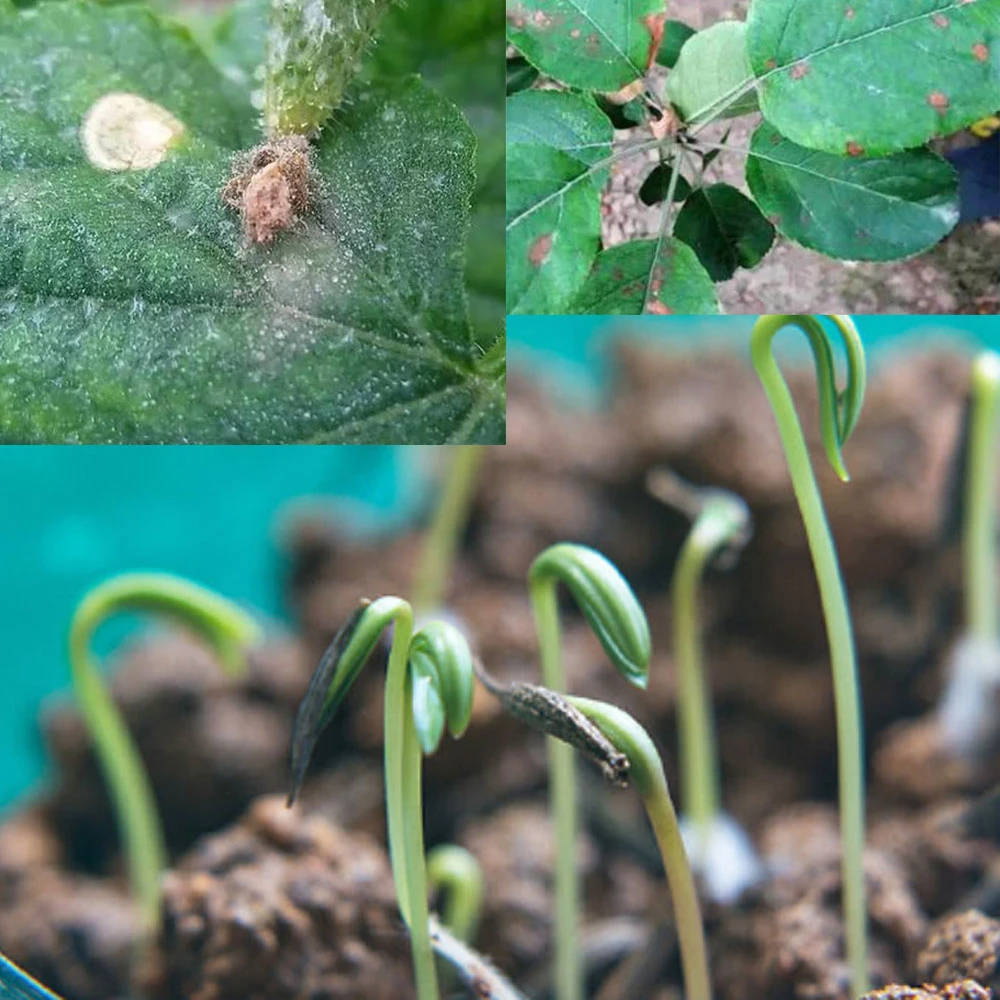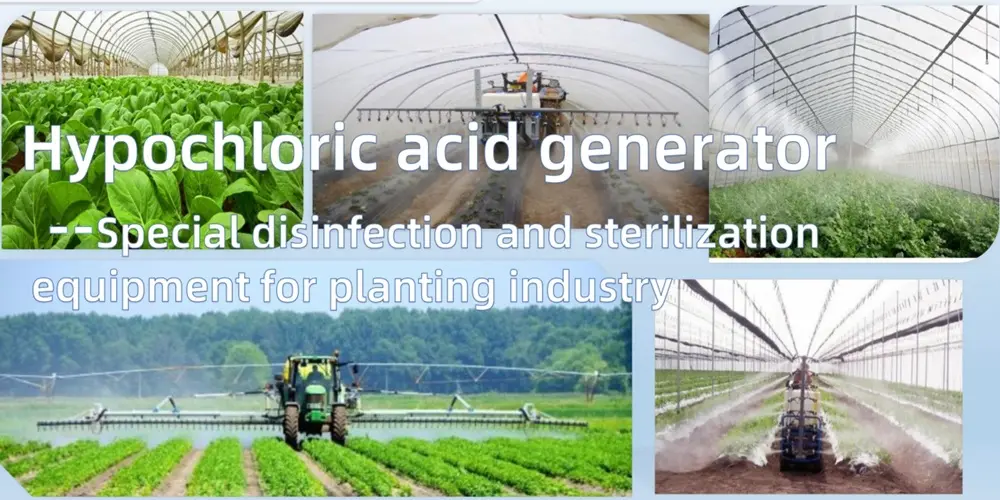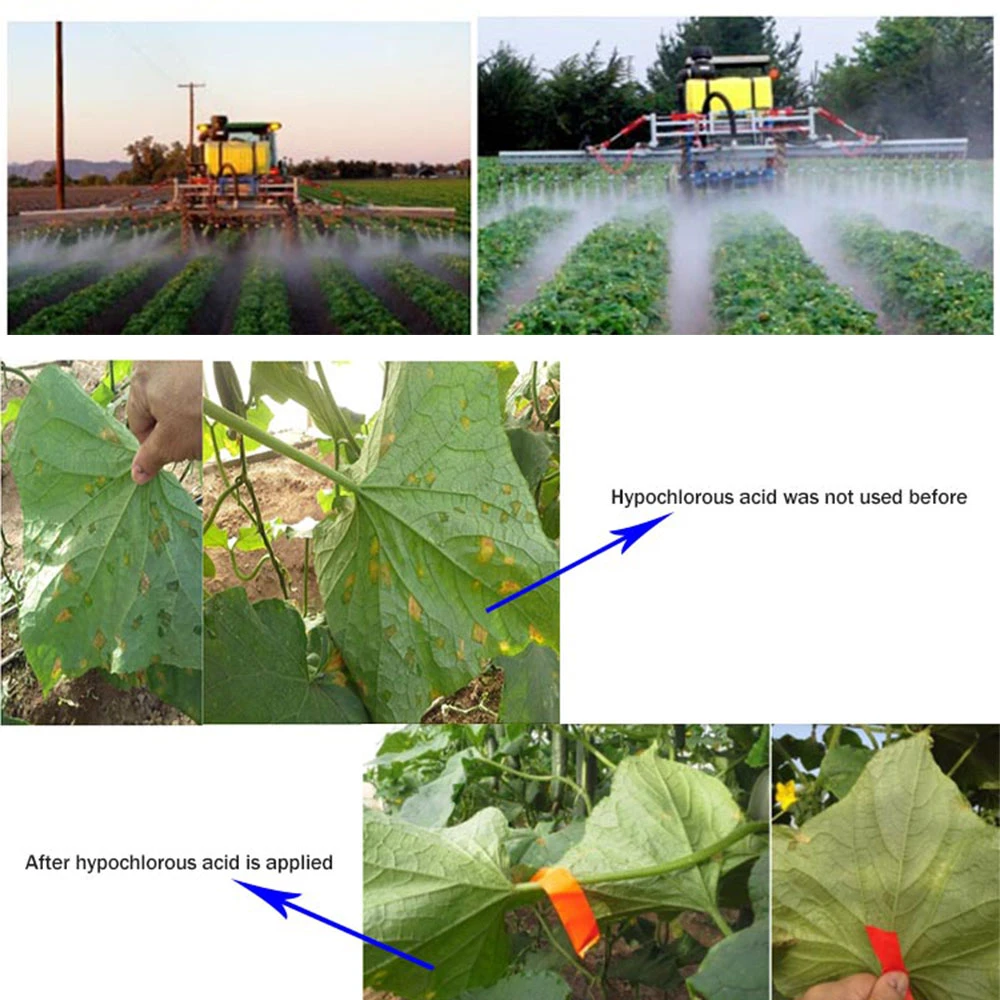Hypochlorous acid generators have extensive application scenarios and significant advantages in agricultural planting.
Hypochlorous acid can solve the problem of pest and disease control in agricultural production, ensuring the freshness of agricultural products after harvest.
It is an efficient, safe and environmentally friendly disinfectant
The working principle of hypochlorous acid generator
Hypochlorous acid generators mainly produce hypochlorous acid (HClO) with strong oxidizing properties by electrolyzing table salt (NaCl)
or potassium chloride (KCl), etc. Take the electrolysis of table salt as an example. In a specific electrolytic device, table salt undergoes a series of chemical reactions.
Firstly, sodium chloride (NaCl) generates sodium hydroxide (NaOH), hydrogen gas (H₂), and chlorine gas (Cl₂) under electrolysis.
The chemical reaction equation is: 2NaCl + 2H₂O → 2NaOH + H₂↑ + Cl₂↑. Then, the generated chlorine gas (Cl₂) will further react with water (H₂O) to form hypochlorous acid,
with the reaction equation being: Cl₂ + H₂O ⇌ HCl + HClO. The oxidation state of chlorine in hypochlorous acid molecules is +1.
This unique chemical structure endows hypochlorous acid with strong oxidizing properties, making it a powerful weapon for disinfection and sterilization.

The application scenarios of hypochlorous acid in agricultural planting
1,Hypochlorous acid can improve the soil and kill pests and diseases
1,1 Kill the pathogens in the soil
In agricultural planting, soil-borne pathogens such as pathogenic bacteria, nematodes and their eggs in the soil are often important sources of crop diseases.
For instance, Fusarium can cause fusarium wilt in various crops, seriously affecting their growth and yield.
Injecting soil with hypochlorous acid solution, usually with a concentration of around 200ppm, can effectively kill these soil-borne pathogens,
with a extermination rate of over 90%. Meanwhile, in combination with the film fumigation technology,
it has a remarkable effect on alleviating the common continuous cropping obstacles of solanaceous crops and others.
1,2 Improve soil microecology
Hypochlorous acid not only has a bactericidal effect, but also can play a positive role in improving the soil micro-ecological environment.
Freshly prepared and produced electrolyzed water with hypochlorous acid not only contains hypochlorous acid but also supersaturated hydrogen,
oxygen and a portion of free hydroxyl groups. When it is applied to the soil, the supersaturated gas escapes rapidly in the form of bubbles.
Among them, hydrogen, as the smallest molecular structure, can penetrate everywhere, while oxygen increases the oxygen content in the soil cavities,
adjusting the soil aggregate structure to a certain extent and improving the physical and chemical properties of the soil.
The hydroxyl and other functional groups activate the toxic substances accumulated in the soil in the form of free radicals, redisperse them along the water flow,
reduce the toxic effects, and create a healthy soil environment for the growth of crop roots. For some soils with overly strong acidity or alkalinity,
applying an appropriate amount of hypochlorous acid for treatment can also neutralize the soil’s pH level, provide a suitable living environment for soil microorganisms, and enhance soil fertility.

2,Hypochlorous acid is used for seed treatment
2,1 Improve the germination rate of seeds
Soaking seeds in acidic hypochlorous acid can, on the one hand, kill the pathogens and parasite eggs outside the seed coat,
reducing the risk of diseases during seed germination and growth. For instance, in the cultivation of soybeans,
soaking soybean seeds in a 30-50 PPM hypochlorous acid solution can kill anthrax bacteria, Rhizoctonia japonicum, etc.,
and increase the germination rate by more than 12%. On the other hand, hypochlorous acid can also improve the permeability of the seed coat,
enhance the water absorption capacity of the seed and the growth rate of the embryo,
which is conducive to promoting seed germination and cultivating strong seedlings.
This method can also achieve good results in the treatment of leek seeds and enhance the disease resistance of the plants.
3,Hypochlorous acid is used for irrigation disinfection
3,1 Prevent the spread of water mold diseases
Irrigation water is an indispensable factor in agricultural production, but it often contains pathogenic microorganisms such as algae and Escherichia coli.
These microorganisms can spread through the irrigation system, causing water-borne diseases in crops. In greenhouses in the Netherlands,
the use of hypochlorous acid to treat circulating irrigation water has effectively reduced the incidence of root rot.
By adding an appropriate amount of hypochlorous acid to the irrigation water, generally controlled at a concentration of 0.5 to 1ppm,
these pathogenic microorganisms in the water can be inactivated, ensuring the sterile state of the irrigation water, thereby preventing the spread of
water-borne diseases and guaranteeing the healthy growth of crops. Meanwhile, hypochlorous acid can also be used to clean the irrigation system,
remove the biofilm in the pipes, prevent the breeding and reproduction of microorganisms in the pipes, ensure the smoothness of the irrigation system,
and improve the utilization efficiency of water resources.

4,The control of diseases and pests during the growth period of crops by hypochlorous acid
4,1 Prevention and control of fungal diseases
During the growth of crops, fungal diseases such as downy mildew and powdery mildew are quite common,
which seriously affect the photosynthesis and yield of crops. Foliar spraying with 50ppm hypochlorous acid can achieve a control effect of 88% on these fungal diseases.
Hypochlorous acid can rapidly destroy the cell wall and cell membrane structure of fungi, making them inactive,
thereby effectively controlling the development of diseases and reducing the use of pesticides by 30% to 50%.
This not only lowers production costs but also reduces the impact of pesticide residues on the environment and the quality of agricultural products.
4,2 Blocking of bacterial diseases
For diseases caused by bacteria, such as bacterial wilt and soft rot, adding 10ppm of hypochlorous acid to
the irrigation water can continuously control the occurrence of these diseases. Take the cucumber cultivation in a certain greenhouse in Weifang as an example. The losses caused by diseases have decreased by 60%. The strong oxidizing property of hypochlorous acid can destroy the cellular structure of bacteria and hinder their metabolism, thereby achieving the purpose of blocking the spread of bacterial diseases.

